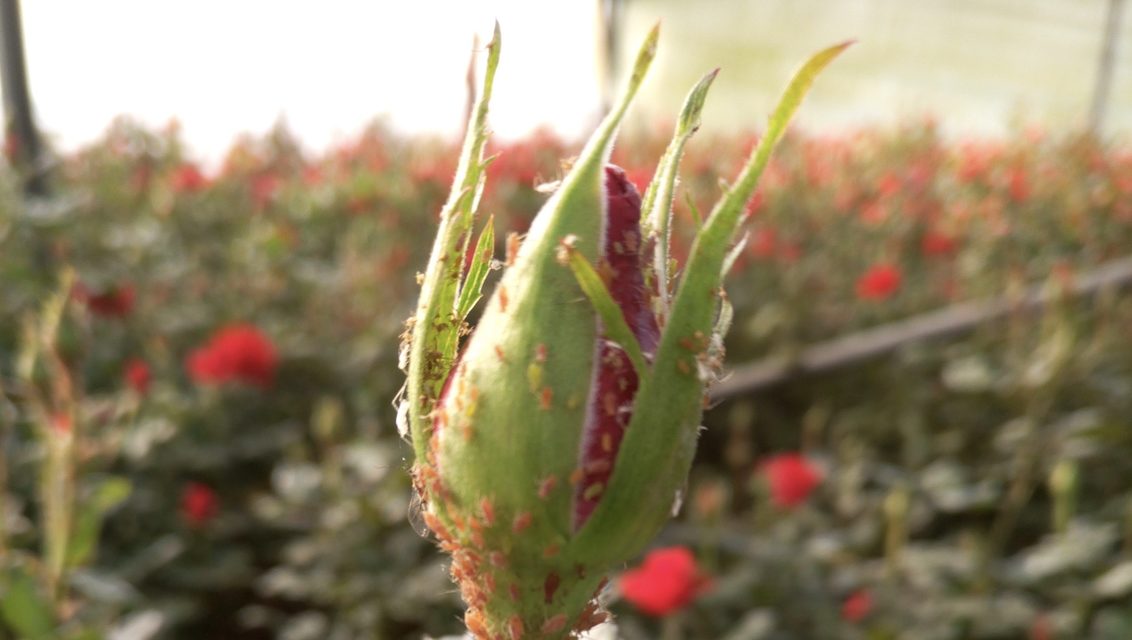Understanding and overcoming resistance mechanisms in aphids
Aphids, Aphidoidea
Aphids reproduce parthenocarpically, without sex. There are many different types of aphids, often with a very specific host.

Aphid colonies in roses
These include:
Melon cotton aphid (Aphis gossypii)
- Potato aphid (Macrosiphum euphorbiae)
The distinguishing features of a potato aphid are:
- antennae as long as the body
- long slender, green siphunculi
- long, finger-shaped cauda
- Glasshouse and potato aphid (Aulacorthum solani)
The distinguishing features of this aphid are:
- Green or yellow-orange patch round base of siphunculus
- Long, slender, tapering siphunculus with dark tip
- Peach potato aphid (Myzus persicae)
The distinguishing features of this aphid are:
- Converging antennal tubercules
- Antennae about as long as the body
- Long siphunculus, slightly swollen, with dark tip
This is the most common and damaging aphid of pot and bedding plants but not common on nursery stock and ornamentals. It is also a widespread and common pest of tomatoes and cucumbers, brassicae, lettuce, potato, sugar beet, oilseed rape and many other plants. Most aphids are easily drawn to yellow sticky traps, which are used to monitor populations in glasshouses. The damage threshold involves merely the presence of these aphids in susceptible crops because of the risk of virus transmission and the effect on crop marketability
Aphids are virus vector and can transmit over 100 virus diseases, such as:
- Lettuce mosaic
- Cucumber mosaic
- Beet western mosaic
Resistance mechanisms in Myzus persiace
M. persicae has developed several mechanisms for disabling pesticides from damaging them. The efficacy of these defence systems varies according to the chemical structure of the pesticide. Generally, resistance to OPs (organophosphates) is greater than that to carbamates and pyrethroids. Enhanced esterase enzyme (E4) Esterase is an enzyme produced by the aphid, which reduces the performance of many insecticides by preventing the chemical from effecting the aphids’ nervous system. The enzyme is produced in varying amounts in Myzus persicae strains, thereby imparting varying degrees of resistance. The level of resistance is described as:
- Susceptible (S)
- Moderately resistant (R1)
- Highly resistant (R2)
- Extremely resistant (R3)
‘MACE’ and kdr resistance mechanisms
In 1995 two new resistance mechanisms were discovered in M. persicae - the modified acetylcholinesterase (MACE) and the knockdown resistance (kdr) mechanisms. Aphids either have or do not have the MACE mechanism, it does not occur to varying degrees, like the esterase mechanism. The kdr mechanism always occurs in association with the E4 mechanism, and so remained undetected until recently as its presence was masked by the presence of E4.
As a result of the MACE mechanism, Myzus persicae has become immune to pirimicarb and triazamate. The performance of other carbamates and OPs is not yet affected. Again this resistance can be detected by a biochemical test. So far these mechanisms (MACE and kdr) are found only in combination with the esterase mechanism (E4), making the aphids that carry all of
them virtually immune to most insecticides.
OP and carbamate insecticides attack the enzyme, acetylcholinesterase which regulates the flow of a chemical messenger across the gap (synapse) between nerve cells. The aphid is killed by the disruption of its nervous system. The MACE and kdr mechanisms work by changing the structure of the protein in the aphids’ body, which is the target of the insecticide applied. This makes them resistant.
MACE resistance to pyrethroids
The passage of signals along the nerve relies on another protein in the insects’ nervous system, called the sodium channel. Pyrethroids keep these channels ‘open’, over-exciting the nervous system and resulting in the death of the death of the insect. The knock down resistance mechanism (kdr) modifies the protein in the sodium channel protein, making it insensitive specifically to pyrethroids.
Managing resistance in Myzus persicae
- Assess the risk to the crop before deciding to spray – so minimizing the number of sprays applied and the consequent selection pressure for resistance to develop.
- Consider the contribution of natural enemies – it might not be necessary to spray.
- Adopt an IPM programme
- Identify aphids correctly – some, such potato aphid, Macrosiphum euphorbiae, and cabbage aphid, Brevicoryne brassicae, are more easily controlled with a wider range of insecticides.
- Carefully consider the risks of crop damage from virus vectors in your area and the possibility of encouraging resistance by overrelying on seed or soil treatments with persistent systemic insecticides such as aldicarb and imidacloprid.
- If you must spray – spray well– get good coverage.
- Alternate chemicals from different groups. Due to the apparently close association between high E4 and kdr resistance Ops and pyrethroids may not be ideal candidates for alternation since either group has the potential to select for resistance to the other.
- Avoid mixtures of insecticides whenever possible when controlling M. persicae. Tank mixtures of insecticides should be avoided.
- Never re-applying a product at doses higher than the manufacturer’s label rate if resistance is suspected – it will invariably be counter-productive as well as illegal
- The use of insecticides is often the only effective means of managing an aphid infestation. Several registered insecticide formulations are available for aphid control. However, to avoid damaging valuable plants, apply the material only to plants that are specified on the label. Be sure to follow all insecticide label directions. Chemical control recommendations: Actara, Chess and Karate Zeon.

